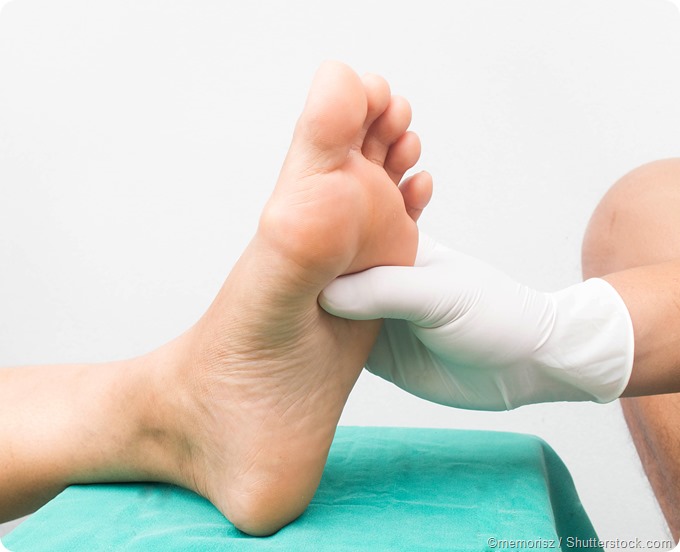
Pins and Needles and Diabetes
Diabetes mellitus is a metabolic disorder caused by the inability of the pancreas to produce sufficient amounts of insulin to deal with the quantity of glucose and other carbohydrates entering the body, or by the insensitivity of the body to the normal action of insulin.

One of the most common complications of diabetes is neuropathy, occurring in 60-70 percent of diabetic patients. This refers to nerve damage caused by abnormally high levels of various metabolites in response to high sugar levels in the blood and tissues. Its prevalence is higher with longer duration of disease, and with age, as well as with unstable or uncontrolled hyperglycemia, hypertension, obesity, and hyperlipidemia.
Causes and symptoms
Neuropathy in diabetes is postulated to be due to:
- Hyperglycemia and hyperlipidemia with hypoinsulinemia
- Vascular dysfunction or damage leading to ischemia of the nerves
- Autoimmune inflammation of nervous tissue
- Inherited traits which make the nerves more prone to damage
- Smoking, alcohol abuse, and other lifestyle factors
Symptoms of diabetic neuropathy depend on which type of nerve is affected. They may range from asymptomatic damage to numbness, with pins and needles, of the extremities, or visceral symptoms due to autonomic neuropathy.
Types of diabetic neuropathy
Diabetic neuropathy is of various types, namely:
- Peripheral neuropathy
- Autonomic neuropathy
- Proximal neuropathy
- Focal neuropathy
The most common type is peripheral neuropathy, which produces:
Pain in the extremities (typically sharp cramps)
- Numbness of the extremities
- Pins and needles in the extremities
- Hyperesthesia
- Loss of coordination or balance, exacerbated by muscle wasting and hyporeflexia – though these are not common.
The symptoms of diabetic peripheral neuropathy usually become worse at night. The condition usually affects the feet, the toes, the legs, hands, and arms. It is a distal symmetric polyneuropathy, and affects the lower limbs first because of the dying-back effect and the increased length of lower limb nerves. Thus the leg up to the knee is typically involved before the fingers begin to experience symptoms.
Both sensory and motor fibers are damaged. A glove-and-stocking distribution is common, with minimal motor symptoms. Secondary complications such as hammertoes, midfoot deformity, blisters, and spreading secondary infection, are quite common.
Diagnosis and management
Diabetic neuropathy is diagnosed by symptoms and physical examination, which includes testing for:
- Blood pressure and other signs of autonomic regulation
- Motor function, including muscle power and reflexes
- Sensory function, including sensitivity to light touch, vibration, temperature, and change in position
- Other nerve or muscle function tests may be required to evaluate how badly and how much of a nerve is affected
Peripheral neuropathy in diabetes frequently leads to amputation; for this reason, foot care is of paramount importance. Daily personal foot examination is mandatory to arrest problems early. In addition, expert appraisal is also recommended, several times a year.
Normalizing blood glucose levels is the first step in managing diabetic peripheral neuropathy. In fact, diabetic peripheral neuropathy is best prevented by a tight control of blood glucose levels. This is achieved by careful monitoring, dietary modifications, exercise, and the use of medications or insulin. Newer treatments to slow down the progress of or to reverse neuropathy are still under study.
Symptomatic treatment may help to control pain. This can range from topical preparations or oral pain-relieving medication to bed cradles which prevent bedding from touching the painful limb. Smoking and drinking increase the risk of amputation and should be stopped, with help if necessary.
References
- https://www.niddk.nih.gov/health-information/diabetes/overview/preventing-problems/nerve-damage-diabetic-neuropathies
- https://www.betterhealth.vic.gov.au/health/conditionsandtreatments/diabetic-neuropathy
- https://www.ncbi.nlm.nih.gov/pmc/articles/PMC2430688/
- https://www.ncbi.nlm.nih.gov/pmc/articles/PMC2596705/
- https://www.ncbi.nlm.nih.gov/pmc/articles/PMC4847561/
Further Reading
Last Updated: Aug 23, 2018























.png)









No hay comentarios:
Publicar un comentario